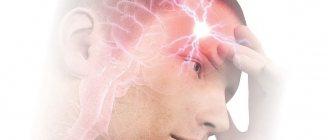Medical information is reliable Checked by Shaidullin Renat Flyurovich
Hallucinosis is a mental disorder in which there is an influx of hallucinations of predominantly one type (visual, olfactory, auditory, etc.) while maintaining the patient’s clear consciousness. Treatment of hallucinosis in Moscow at Dr. Isaev’s clinic is carried out by the most experienced specialists, using modern approaches to therapy.
This condition often occurs as a secondary condition, and therefore help is provided primarily in the form of an impact on the underlying pathology. Before the development of hallucinations, anxiety, fear, and motor restlessness appear, and are often accompanied by delusional ideas of identical types.
Causes and types of hallucinosis
Correct treatment of hallucinosis is impossible without identifying the etiological factor of its development. The main reasons for this deviation are:
- epilepsy;
- traumatic brain injury;
- dysfunction of the central nervous system;
- brain tumors of a benign or malignant nature;
- schizophrenia;
- severe infectious disease;
- withdrawal symptoms and acute alcoholic hallucinosis;
- intracerebral hemorrhage.
Sometimes this pathology occurs in isolation, such as Charles Bonnet hallucinosis, described in elderly patients. But more often it is based on mental or somatic disorders.
Before starting treatment for hallucinosis, it is necessary to determine the type of its course. It can be:
- spicy;
- subacute;
- chronic.
The acute variant occurs suddenly, against the background of complete well-being. It is preceded by a prodromal period, which lasts from 2-3 hours to several days. The subacute variant is characterized by the initial appearance of severe anxiety and fear, depression and frequent mood swings. In this case, treatment for anxiety and the use of sedatives may be necessary. The chronic type of hallucinosis is rare and usually lasts from 2 to 10 years.
Depending on the etiology, the following hallucinatory-paranoid syndromes are distinguished:
- organic (for brain diseases);
- atherosclerotic (has a chronic course with increasing symptoms);
- alcoholic (occurs against the background of giving up alcohol after drinking binges).
Literature:
- Goffman A.G. Clinical narcology. - M.: "MIKLOSH", 2003. - 215 p.
- Guide to Narcology // Ed. N.N. Ivanets. - M.: Medpraktika-M, 2002. - 444 p.
- Egorov A.Yu., Aleksin D.S., Petrova N.N. Features of alcoholic psychosis in a psychiatric clinic. - Bulletin of St. Petersburg State University, 2011. - Ser. 11, no. 1.
- Shuvalov S.A., Chuprova N.A., Brodyansky V.M. and others. Clinical and genetic markers of the development of acute alcoholic psychoses and convulsive seizures in patients with alcohol dependence. - Russian Psychiatric Journal, 2014. - No. 6.
General symptoms of hallucinosis
A common feature for all hallucinosis is the person’s retention of consciousness. The patient understands who he is, what time it is, and where he is. Otherwise, the clinical picture of the problem depends on the type of disease. Charles Bonnet syndrome causes:
- cartoon visions;
- people with distorted facial features;
- hallucinations appear and disappear suddenly;
- The pictures are saved in full.
Often this phenomenon is combined with atherosclerosis, and sometimes accompanies senile dementia, in which case hallucinosis is eliminated and Alzheimer's is treated.
In Lhermitte's disease, hallucinosis manifests itself somewhat differently:
- observed in the dark;
- They look like vague images of animals or people.
In the verbal form of the disease the following are noted:
- voices (one or several);
- they discuss him and his surroundings;
- ordered to perform certain actions.
Treatment of hallucinosis of alcohol origin is carried out after consultation with a narcologist; this type of mental disorder is characterized by the following symptoms:
- high anxiety;
- fear without reason;
- vivid and believable visual images;
- voices coming from objects;
- obsessive thoughts about death or the death of relatives;
- sleep disturbance;
- suicide attempts.
Features of organic hallucinosis
When a deviation occurs, the person is fully conscious and can think critically about the problem. Treatment of hallucinosis in Moscow is carried out mainly in people from 45 to 65 years old, most often women become patients.
Numerous experimental works by scientists indicate that hallucinations arise as a result of irritation of certain parts of the brain. Most often, the organic form of hallucinosis occurs due to the presence of intoxication due to an infectious disease, neurological or vascular disease, or disruption of the functioning of the sensory organs. The following factors can provoke the appearance of this deviation:
- taking psychostimulants (alcoholism and drug addiction);
- drug poisoning;
- damage to brain tissue by tumor, injury;
- epilepsy;
- migraine with pre-existing aura;
- oxygen starvation of brain structures due to vascular disorders;
- deafness and blindness.
With this form of disorder, the patient’s comprehension of what is happening is slower than that of a healthy person. This phenomenon is often used in the diagnosis of deviation. Treatment of hallucinosis in this case is necessary, since the disease can progress rapidly and lead to severe apathy and memory impairment. The patient also exhibits the following symptoms:
- poverty of associations;
- reluctance to engage in conversations;
- emotional stinginess;
- lethargy and dysphoria;
- causeless aggression (sometimes);
- impulsiveness;
- difficulty controlling emotions;
- stereotypical speech and thinking.
The course of alcoholic hallucinosis
Treatment of hallucinosis caused by drinking alcohol-containing strong drinks is carried out in a drug treatment clinic or a specialized department. Its main difference from alcoholic delirium is that the patient remains conscious and is able to navigate in space.
In this case, a person experiences predominantly auditory hallucinations, most often accompanied by delusions. He hears voices from the outside that threaten to kill him or the cries of his children and loved ones asking for help. Sounds can be monotonous or increasing in nature, disappear and appear again.
This phenomenon causes the formation of paranoid tendencies, when treatment of persecutory mania, severe fear and anxiety may be required. The appearance of such a disorder is preceded by a change in mood, which the patient characterizes as severe melancholy and reluctance to live.
Alcoholic hallucinosis occurs with prolonged consumption of large doses of alcohol. Most often it is registered in people who have been drinking for 10-15 years or more, in the second or third stage of addiction. Tolerance to ethyl alcohol in such patients is usually higher than in persons with manifestations of delirium. There are studies proving that hallucinosis occurs when ethanol and its breakdown products damage the hypothalamus in the body. And withdrawal syndrome further provokes the formation of this deviation.
Prevention of relapse
Intensive treatment in a hospital does not mean that alcoholic hallucinosis will not happen again. To prevent a repeat episode, comprehensive therapy for alcoholism is necessary. The best option is to undergo a course of physiotherapy, hardware cleansing, and psychotherapy in a clinical setting.
After normalization of health, comprehensive diagnostics and consultations with highly specialized specialists are necessary. As a rule, with such a long period of alcohol abuse, chronic diseases of the liver, pancreas, and heart failure are diagnosed. And it is not only alcoholism that requires treatment, but also associated pathologies.
The final stage of therapy is rehabilitation. Modern drug treatment clinics offer various readaptation schemes. The most common is the 12-step system and one of its variations (Minnesota model), excellent results are noted after rehabilitation using the Shichko method.
How is the disease diagnosed?
Treatment of hallucinosis in Moscow and other cities is based primarily on the diagnosis. He identifies according to the clinical picture and characteristic manifestations of the disease. For an experienced neurologist, narcologist or psychiatrist, it is usually not particularly difficult to establish this disorder. This requires:
- study medical history;
- get acquainted with the medical history;
- observe the patient for some time;
- conduct a series of neurological tests;
- interview the patient and his relatives in detail.
With primary hallucinosis, this is enough. If it acts as a secondary manifestation of the underlying disease, then laboratory and instrumental studies are required. They will confirm or exclude the presence of organic lesions that cause hallucinations. Usually prescribed:
- electroencephalogram;
- MRI and CT scan of the brain;
- Ultrasound examination of his vessels.
Treatment of hallucinosis of organic origin is carried out only after excluding other diseases that occur in a similar way:
- drug or alcohol psychosis;
- schizophrenia;
- mental disorders accompanied by delusional ideas.
If hallucinations develop during psychosis when using ethyl alcohol or psychotropics, visions and hallucinations occur, but the person’s clarity of consciousness is not determined. Schizophrenics often experience pseudohallucinations, delusions, and a lack of criticality towards their condition. In this case, consultation with a psychiatrist will help differentiate the pathology. With a delusional disorder, delusion comes first, then it is primary and requires a slightly different approach to providing assistance.
Service price
- HOSPITAL Day hospital5 000
- Day hospital with intensive care8,000
- 24-hour hospital (all inclusive, cost per day) 12,000
- 24-hour hospital (all inclusive, cost per day). Single occupancy24,000
- 24-hour hospital (all inclusive, cost per day). Single occupancy in a superior room 36,000
- Primary family counseling for relatives of patients undergoing inpatient treatment free of charge
- Group psychotherapy for relatives of patients undergoing inpatient treatment free of charge
- Group psychotherapy for 24-hour and day hospital patients free of charge
- Individual post for a hospital patient (if indicated)6,000
Hallucinosis is a painful condition characterized by the constant presence of hallucinations (deceptions of perception) with clear consciousness.
In the presence of the phenomenon of pseudohallucinations, they speak of pseudohallucinosis. Pseudohallucinations are false perceptions localized within the body (in the head, in the body), characterized by a feeling of being made by someone from the outside. For example, a voice sounding in the head is perceived as “induced by someone and purposefully influencing.”
Organic hallucinosis treatment
Treatment of hallucinosis in Moscow, which has an organic origin, is becoming increasingly relevant. Experts attribute this to the increase in people's life expectancy, which increases the number of special cases of senile mental disorders. A large amount of stress experienced and constant tension in the nervous system, characteristic of a resident of a large metropolis, lead to a high risk of developing various diseases. The complexity of therapy in this case is determined by the selection of drugs that can be used in elderly people.
Most often, combination therapy of two drugs, which may belong to different groups, is used. Treatment of hallucinosis begins with minimal doses with a gradual increase, and continues until a satisfactory clinical picture is obtained at a maintenance dosage. Usually used in different combinations:
- neuroleptics;
- anticonvulsants;
- antipsychotics;
- anti-anxiety medications;
- antidepressants.
Therapy is also aimed at eliminating or reducing the influence of the underlying disease and, if the course is mild and there is no danger to the patient and others, it can be carried out on an outpatient basis. Severe forms of organic hallucinosis require hospital care. It makes it easier to prescribe treatment and monitor the body’s reaction to a particular drug.
Alcoholic hallucinosis treatment
Treatment of hallucinosis of alcoholic origin is carried out in a narcology setting. Therapy in this case has the following goals:
- carrying out intensive detoxification;
- elimination of mental disorders;
- normalization of metabolic processes;
- restoration of organ function;
- prevention of cognitive impairment.
To remove toxic products of ethanol, saline solutions with glucose, adsorbents, B vitamins, and ascorbic acid are used. At the same time, cerebral circulation is improved with the help of nootropics, and symptomatic therapy is selected individually.
In acute manifestations of the disease, parenteral administration of antipsychotics and tranquilizers is practiced. Treatment of hallucinosis in alcoholics should begin as quickly as possible, only in this case is it possible to get rid of the pathology in a short time. With chronic hallucinases, it is necessary to resort to more radical and lengthy methods of therapy. A prerequisite for recovery is a complete abstinence from drinking alcoholic beverages.
To consolidate the result after relieving an acute condition, it is necessary to visit “Alcoholics Anonymous” groups and work with a psychotherapist. The specialist will teach you how to enjoy life without resorting to the use of psychotropics and alcohol. It will also help improve relationships in the family and at work. You can undergo complete social rehabilitation in a specialized center.
Treatment of hallucinosis in acute alcoholism lasts no more than a month. A number of patients remain depressed (more often in women), and may require additional treatment for dysthymia, which can be easily treated with selective serotonin reuptake blockers. The chronic form of the disorder, provided there is no influence of ethyl alcohol on the body, can occur in the form of long-term remissions and exacerbations under provoking factors (stress, fatigue). In this case, a person’s intellectual abilities do not suffer.
Questions and answers
Is it possible to get rid of hallucinosis completely?
It is difficult to predict the result with this deviation. Much depends on the underlying disease that causes hallucinosis. It is necessary to detect it as early as possible, and in this case, doctors have a much higher chance of achieving a positive result.
What will happen if treatment is not carried out?
In the complete absence of therapy, a person’s condition is highly likely to worsen. He can become dangerous to himself and his surroundings. Severe depression, which often accompanies advanced cases, often leads to suicide attempts. The development of behavioral and emotional disorders, a decrease or complete cessation of social activity is possible.
Types of hallucinations
With hallucinosis, perception is impaired. The patient hears, sees or feels something that does not really exist. There are three categories of such disorders, in accordance with the three senses “responsible” for them.
Visual
With such hallucinosis, the patient sees objects that do not exist in reality. These may be fleeting, elusive images on the periphery of vision. They disappear if you try to look at them and focus. Visions can be clear and vivid. An elderly person can see his friends or relatives, animals, mythical creatures and even communicate and interact with them.
Auditory
Usually progresses: the first hallucinations are manifested by simple sounds. It seems to the patient that something is knocking, rustling, or rattling somewhere, but the source of the noise cannot be found. Gradually the sounds become more complex, he can hear speech and addresses addressed to him. More often they are negative in nature, these are accusations, insults, threats. With auditory hallucinations, a person may communicate with voices that only he or she can hear.
Tactile
They manifest themselves as unpleasant sensations: the patient experiences itching, it seems to him that insects and parasites are running over the skin. He may even see them if the disorder is accompanied by visual hallucinosis. The sensation may be accompanied by burning and pain. This interferes with sleep, irritates, increases anxiety, which is why a person’s mental state worsens.
Hallucinations related to smell or taste are relatively rare in older people.
You have questions? We will call you back within 30 seconds
or call the number
Clicking the "Submit"
, you automatically consent to the processing of your personal data and accept the terms of the User Agreement.










